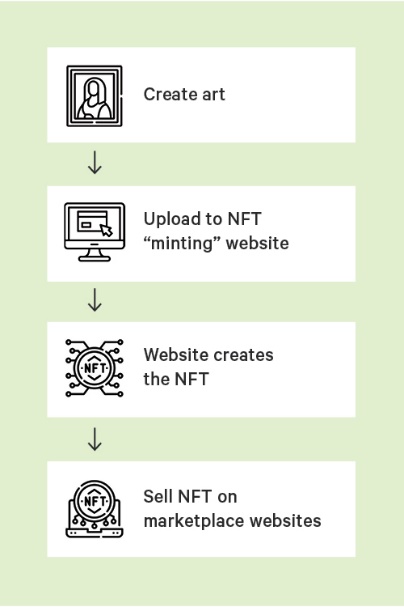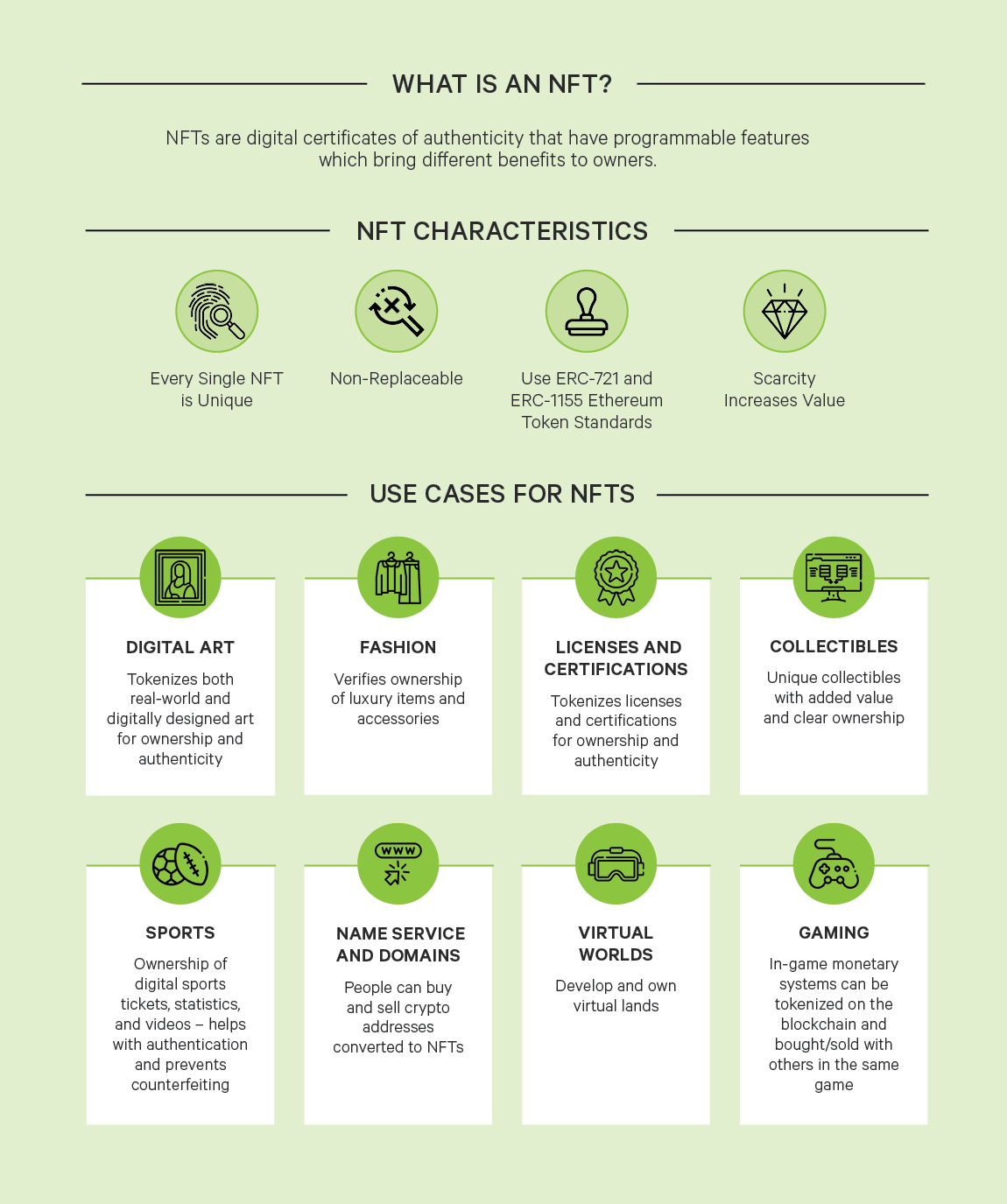NFTs
What is non-fungibility?
All currencies, fiat or digital, have a common attribute called fungibility. When we trade one coin for another, we depend on a framework that makes both exchangeable because each is equal to any other coin of the same currency. One USD or one bitcoin is always equal to another USD or another bitcoin, respectively. The assurance that one USD can always be exchanged for another USD and one bitcoin can be exchanged for another bitcoin is central to making both USDs and bitcoins accepted ways of paying and transferring value between people.
However, certain things cannot be exchanged for their equal because such an equal item does not exist. An original Renoir painting or a unique opera performance does not have equals. It is possible to copy them, but those copies, however exact, will never be equal to the original. This increases the value of the originals because such originals are unique and therefore nonfungible. They cannot be replaced or exchanged for a similar item because they do not have an equal. Such items are not illiquid: liquidity is the ease with which an item can be exchanged for another. An illiquid asset such as real estate or privately held shares of a company can eventually be sold for something that is of equal value. Nonfungible items cannot be exchanged at all, although they can be sold in exchange for cash or another tangible or intangible property that is equal in value to the valuation placed on the nonfungible item.
When it comes to digital items, it might seem impossible to have nonfungible items since any digital object can be copied exactly with absolutely no difference between the original and the copy. The infinite copies that one can make of a digital object can devalue the object over time. Hence digital scarcity is an important notion in pricing digital assets. By placing an absolute limit on the number of copies that can be made, the price of a digital asset can be managed. A nonfungible digital item can be created by having ownership rights that users can purchase to ensure that the digital item becomes nonfungible. So though copies may be made, the original object is secured through a digital signature by the person who purchased it.
NFTs are digital certificates of authenticity that have programmable features which bring different benefits to owners. With nonfungible tokens or NFTs, it is possible to own and even transfer the ownership of unique digital items. It is also possible to extend this to physical items such as collectibles. Ownership rights are secured digitally forever. Due to the blockchain technology that underpins NFTs, ownerships rights are tamper-resistant and immutably recorded on a block.
Most NFTs run on the Ethereum blockchain and have the programmable features of smart contracts. Since NFTs are tokens generated digitally, they can be used to secure ownership of both tangible and intangible items. Besides artwork, collectibles and real estate, NFTs can also be generated for tweets and several other kinds of internet content. Even when NFTs are created for a set of copies, the blockchain keeps a record of who owns each copy. As the internet can potentially turn into digital objects with ownership rights, the use cases as well as the mania surrounding NFTs have been growing.

Features of NFTs
Unique: Each NFT is a digital representation of unique objects and copies can always be distinguished from the original due to the cryptographic signature of the NFT.
Permissionless: Since NFTs use a peer-to-peer network, there is no central intermediary that regulates or authorizes NFTs.
Smart contract capability: Most NFTs run on the Ethereum blockchain or on other blockchains that also have smart contract capabilities. This programmability allows auto execution that is transparent, tamper-free, and cost effective.
Permanent: Any record on a blockchain is immutable and information in an NFT is permanent.
Digital Ownership: Owning an NFT allows complete control over the way it is used.

Use cases of NFTs
Digital content: Today, content that is generated belongs to the platform or company whose website it is launched on. However, with NFTs, it is possible to own the content even after launching it on websites.
Since several NFTs are on the Ethereum blockchain, they can work with DeFi smart contracts to enable financial transactions. For example, NFTs can be used as collateral for loans that are placed within a smart contract.
Though NFTs can be bought and sold, the original creator can receive royalties for each transaction, much like the author of a book who receives royalties when the book is sold. NFTs also expand liquidity since they can be used as collateral for loans.
Gaming often involves the purchase of items. With NFTs, the ownership of such items purchased in games can be made transparent and immutable. So even if the game developers stop maintaining a game, the NFTs are still owned by the players who purchased them and can even have resale value after the game itself has ended.
NFTs for domain names can be a way of owning internet domains.
For real world objects, NFTs can become a fool proof way of having ownership and may even potentially secure such objects from theft.
The sometimes lengthy process of verifying licenses and certificates can be shortened considerably through NFTs which are counterfeit-proof by nature.
Concerns
While NFTs are a handy tool to have digital ownership of both digital objects and off-chain items, concerns about it abound.
Rather like the tulip mania of 17th century Holland, the NFT craze seems to be irrational at times.
Unlike traditional assets, the value of an NFT depends on demand and supply. NFTs create digital scarcity and so restrict supply. However, if demand drops then the price of NFTs will come down as well.
Several NFT scams have resulted in artists’ work being sold through NFTs without their knowledge.
An NFT merely indicates ownership rights. It does not prevent copies being made of the object. So since originals and copies of digital objects are indistinguishable, NFTs for digital items may be nothing but ‘bragging rights’.
The criticism levelled at blockchains and cryptocurrencies that their energy consumption is an environmental concern extends to NFTs as well.
Not all NFT sales and purchases meet the Howey test for securities under the U.S. Securities and Exchange Commission rules. When the NFT allows ownership of a company or an investment in a common enterprise with the expectation of profit, then they may be seen as investment securities. However, when they are used as purchases or sale of private art or other private items, then the SEC definition of a security does not appear to apply to them, creating confusion at times
Nevertheless, NFTs do indicate some new possibilities for ownership of digital and non-digital assets and have created a new buzz that will likely be around for quite some time.



